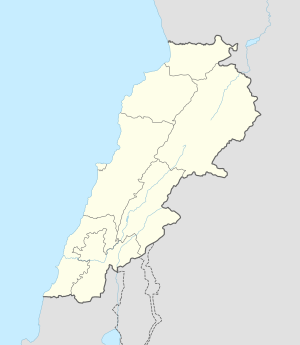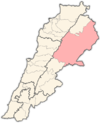Iaat
34°3′58.36″N 36°9′15.52″E / 34.0662111°N 36.1543111°E
Iaat | |
|---|---|
Town | |
 A photograph of the column from the first quarter of the 20th century | |
| Coordinates: 34°03′58.4″N 36°09′15.5″E / 34.066222°N 36.154306°E | |
| Country | |
| Governorate | Baalbek-Hermel |
| District | Baalbek |
Iaat (Arabic: إيعات also transliterated as Ya'ad, Yaad, Yaat, or Iaad) is a town and municipality located in the Beqaa Valley of Lebanon mostly famous for its Corinthian column. The column stands at 18 meters[1] (59.1 feet) it is installed on a 4-step base. The location of the Pillar is 4 miles (6 km) northwest of the Baalbek ruins, between the towns of Baalbek and Chlifa. At one point a plaque was installed on the northern side of the monument; however, it has been removed and no other history is known of the column, which is believed to be a funerary monument. The column is also widely believed in local legend to be related to St. Helena.[2][3]
George F. Taylor classified it among a group of Temples of the Beqaa Valley and noticed that the position of the Iaat column was equidistant between the temples of Baalbek and Qasr el Banat. Whilst technically not being a temple, Taylor suggested that the column might have been placed where it is as a victory column to mark the site of a great ancient battle. He also noted a cartouche on the sixth cylinder of the column.[4]
References
- ^ Iaat, Lebanon.Com
- ^ Nelles Verlag (1 December 1999). Syria Lebanon. Hunter Publishing, Inc. ISBN 978-3-88618-105-6. Retrieved 2 November 2012.
- ^ Daniel Krencker; Willy Zschietzschmann (1938). Römische Tempel in Syrien. W. de Gruyter. ISBN 978-3-11-004989-3. Retrieved 2 November 2012.
- ^ George Taylor (1967). The Roman temples of Lebanon: a pictorial guide. Dar el-Machreq Publishers. Retrieved 2 November 2012.


